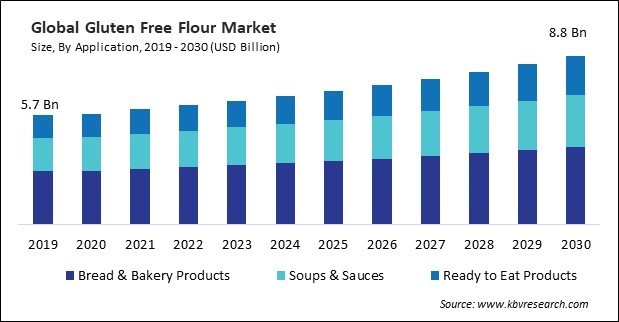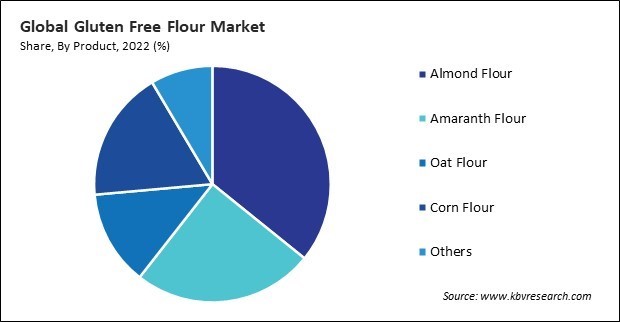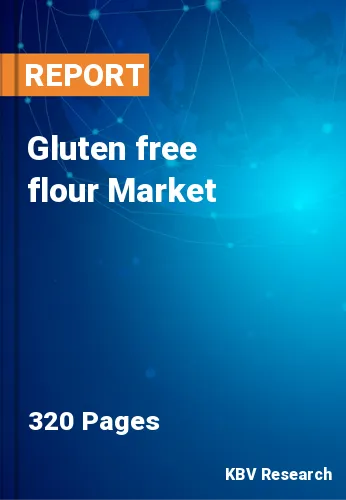“Global Gluten free flour Market to reach a market value of USD 8.8 Billion by 2030 growing at a CAGR of 4.5%”
The Global Gluten Free Flour Market size is expected to reach $8.8 billion by 2030, rising at a market growth of 4.5% CAGR during the forecast period. In the year 2022, the market attained a volume of 834.5 Kilo tonnes, experiencing a growth of 4.6% (2019-2022).
The high fiber range in oat flour can contribute to feelings of fullness and satiety. Consequently, the oat flour segment captured $811.6 million revenue in the market. Oat flour contains essential minerals like phosphorus and magnesium, crucial for maintaining healthy bones and teeth. These minerals contribute to bone density and stability. Pure oats are inherently gluten-free, making oat flour appropriate for people with gluten sensitivity or celiac disorder. Including oat flour in the diet may assist in regulating appetite and lower overall calorie intake, which can benefit weight management.

Manufacturers are exploring a variety of alternative grains and seeds to create gluten-free flours. Options such as quinoa flour, amaranth flour, teff flour, and buckwheat flour offer unique flavors, textures, and nutritional profiles, providing consumers with a broader range of choices. The use of nut and seed flour, such as almond flour, coconut flour, and hazelnut flour, has gained popularity in gluten-free baking. These flours contribute distinct flavors and offer nutritional benefits, including protein and healthy fats. Additionally, modern lifestyles often leave consumers with limited time for food preparation. The demand for convenience foods, including gluten-free options, has surged as individuals seek quick and easy solutions for meal preparation. Gluten-free flours are essential ingredients in formulating convenient mixes and ready-to-use products. Gluten-free flour is a fundamental component of pasta mixes for those who prefer gluten-free alternatives. These mixes provide a convenient way to prepare gluten-free pasta at home, catering to the demand for diverse and convenient meal options. Therefore, the above-mentioned factors will drive market growth in the coming years.
However, many of these flours are derived from alternative grains, nuts, seeds, and legumes, which can be more expensive to cultivate, harvest, and process than traditional wheat. The specialized nature of these ingredients contributes to higher production costs. Additionally, the demand for gluten-free products, including flour, is often lower than that for conventional wheat-based products. Limited demand reduces the economies of scale that manufacturers can achieve, leading to higher per-unit production costs. Manufacturers must invest in monitoring and testing protocols to guarantee their products' gluten-free status. They often invest in educating customers about the benefits of gluten-free products, including using specific flour. Marketing and educational efforts add expenses that influence the overall cost structure. Due to the above factors, market growth will be hampered in the coming years.
On the basis of product, the market is segmented into amaranth flour, almond flour, oat flour, corn flour, and others. In 2022, the almond flour segment dominated the market with the maximum revenue share. Almond flour is fatty in heart-healthy monounsaturated fats, which can contribute to improved cardiovascular health. These fats have been associated with lowering bad cholesterol levels and promoting heart health when consumed as part of a balanced diet. Adequate fiber intake helps maintain regular bowel movements, sustains a healthy gut microbiome, and can contribute to feelings of fullness, aiding in weight management. Almond flour is a nutrient-dense option, providing essential vitamins and minerals. It is a good origin of healthy monounsaturated fats, vitamin E, magnesium, and protein. These nutrients contribute to prevailing well-being and can complement a balanced diet.

By application, the market is classified into bread & bakery products, soups & sauces, and ready to eat products. In 2022, the bread & bakery products segment registered the highest revenue share in the market. Gluten-free flour is commonly used to make muffins and cupcakes. This allows those with gluten restrictions to enjoy various flavors and textures, from blueberry muffins to chocolate cupcakes. The choice of gluten-free flour can influence the taste and consistency of the final product. Gluten-free flour is a key ingredient in gluten-free cookie recipes. The wide range of gluten-free flours allows for creative combinations that produce cookies with different textures, from chewy and soft to crisp and crumbly.
Based on source, the market is fragmented into cereals and legumes. The cereals segment garnered a significant revenue share in the market in 2022. Certain gluten-free cereals, like millet, contain nutrients such as iron and zinc that support nutrient absorption in the body. This can be particularly beneficial for people with deficiencies in these minerals. Many gluten-free cereals are part of sustainable agricultural practices. For instance, millet and sorghum are drought-resistant and can thrive in arid conditions, making them environmentally friendly options for cultivation. Cereal-based gluten-free flours, particularly those derived from whole grains, can contain antioxidants. These compounds help neutralize free radicals in the body, contributing to overall health and reducing the risk of chronic diseases.
Free Valuable Insights: Global Gluten free flour Market size to reach USD 8.8 Billion by 2030
Region-wise, the market is analysed across North America, Europe, Asia Pacific, and LAMEA. In 2022, the Europe region witnessed the largest revenue share in the market. Europe has a higher prevalence of gluten-related disorders, creating a larger consumer base for gluten-free products. Moreover, strict food labeling regulations in Europe ensure clear and reliable labeling of gluten-free products, enhancing consumer trust. In addition, European consumers are more health-conscious and have a higher disposable income, making them more inclined to purchase gluten-free products. The availability of gluten-free flour in mainstream retail channels has expanded, making these products more accessible to consumers across Europe.
| Report Attribute | Details |
|---|---|
| Market size value in 2022 | USD 6.2 Billion |
| Market size forecast in 2030 | USD 8.8 Billion |
| Base Year | 2022 |
| Historical Period | 2019 to 2021 |
| Forecast Period | 2023 to 2030 |
| Revenue Growth Rate | CAGR of 4.5% from 2023 to 2030 |
| Quantitative Data | Volume in Kilo Tonnes, Revenue in USD Billion, and CAGR from 2019 to 2030 |
| Number of Pages | 320 |
| Number of Tables | 710 |
| Report coverage | Market Trends, Revenue Estimation and Forecast, Segmentation Analysis, Regional and Country Breakdown, Porter’s 5 Forces Analysis, Company Profiling, Companies Strategic Developments, SWOT Analysis, Winning Imperatives |
| Segments covered | Source, Product, Application, Region |
| Country scope |
|
| Companies Included | Bob's Red Mill Natural Foods, Inc., Ardent Mills, Associated British Foods PLC, General Mills, Inc., Archer Daniels Midland Company, King Arthur Baking Company, Inc., Shipton Mill Ltd.,Hometown Food Company, To Your Health Sprouted Flour Co. and The Scoular Company |
By Application (Volume, Kilo Tonnes, USD Billion, 2019-2030)
By Source (Volume, Kilo Tonnes, USD Billion, 2019-2030)
By Product (Volume, Kilo Tonnes, USD Billion, 2019-2030)
By Geography (Volume, Kilo Tonnes, USD Billion, 2019-2030)
This Market size is expected to reach $8.8 billion by 2030.
Growing product innovation and variety are driving the Market in coming years, however, High cost of ingredients restraints the growth of the Market.
Bob's Red Mill Natural Foods, Inc., Ardent Mills, Associated British Foods PLC, General Mills, Inc., Archer Daniels Midland Company, King Arthur Baking Company, Inc., Shipton Mill Ltd.,Hometown Food Company, To Your Health Sprouted Flour Co. and The Scoular Company
In the year 2022, the market attained a volume of 834.5 Kilo tonnes, experiencing a growth of 4.6% (2019-2022).
The Legumes segment is leading the Market by Source in 2022; there by, achieving a market value of $6.1 Billion by 2030.
The Europe region dominated the Market by Region in 2022, and would continue to be a dominant market till 2030; there by, achieving a market value of $3,108 Million by 2030.
Our team of dedicated experts can provide you with attractive expansion opportunities for your business.

 Drivers
Drivers
 Restraints
Restraints
 Opportunities
Opportunities
 Challenges
Challenges
